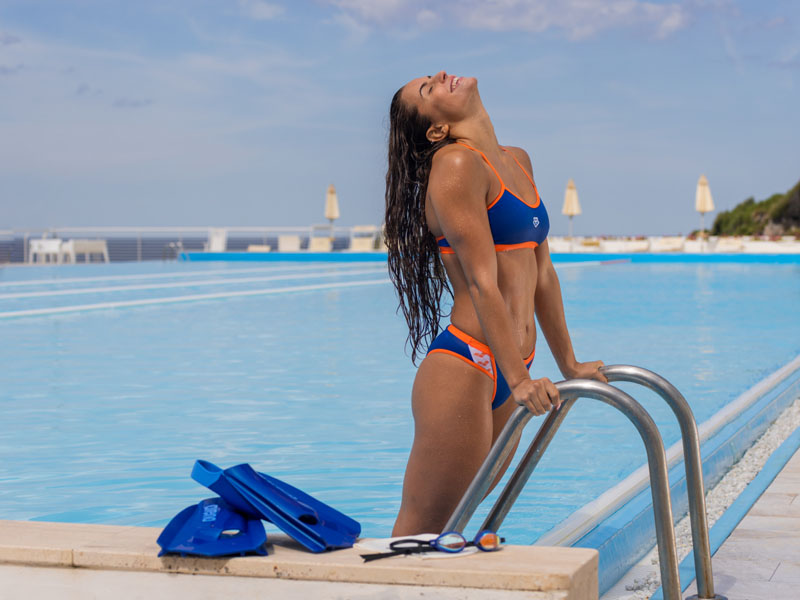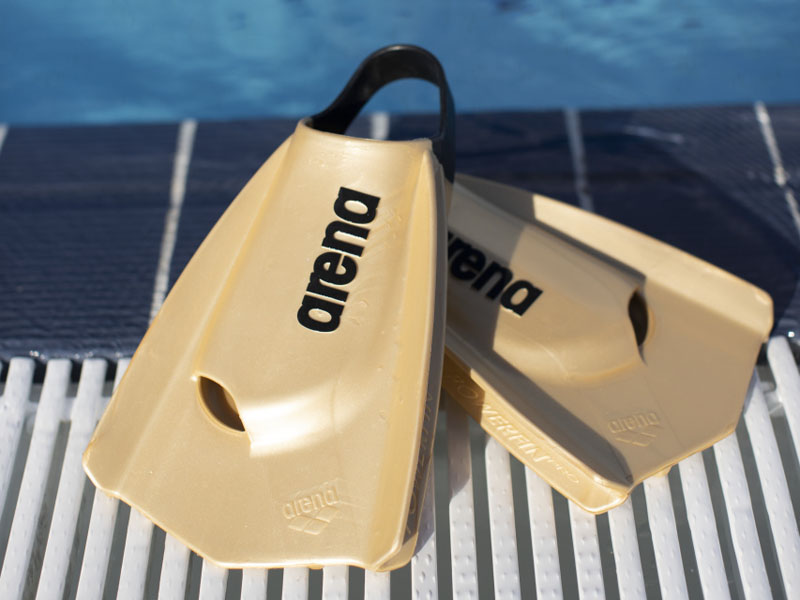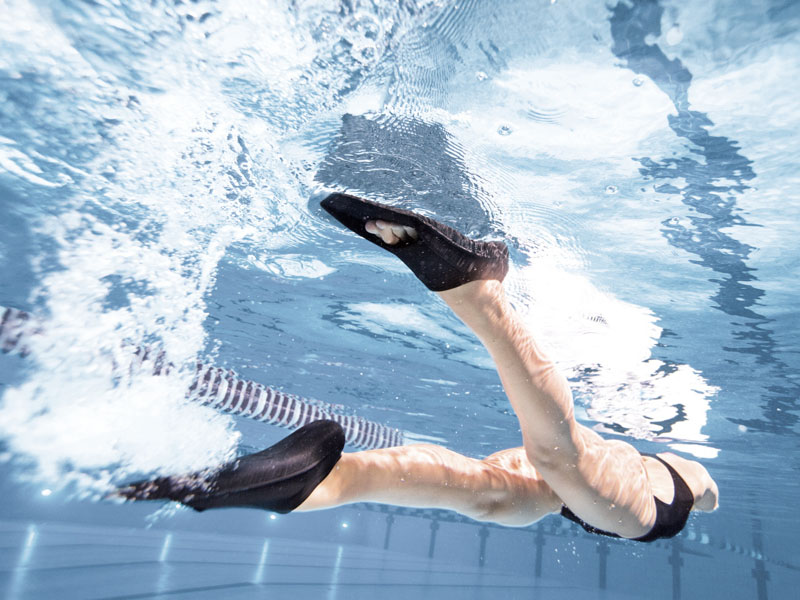Swimming With Fins Workouts to Develop a Stronger Kick
Swimming with fins is one of the most thrilling aspects of swim training. Throw a pair of fins on your feet and get ready to zip through the water at incredible speeds. Fins aren’t just a fun way to mix up your swim routine though; they also act as excellent training tools to practice your technique, increase leg strength, improve flexibility, and help to prevent shoulder injury.
In this article, we’re going to explain why swim fins are advantageous for your swimming skills. We’ll also cover some of the downsides of using fins, like developing blisters and overusing them in training. Then, we’ll guide you through what to look for when selecting a new pair of swim fins, and end with a few swimming with fins workouts.
The Advantages of Training With Swim Fins
The swim fin is likely the most favored piece of swimming equipment on the pool deck. There’s nothing like flying through each lap of your swim set and making a fast interval with ease. After you finish your first swimming with fins workout and come down from that feeling of gliding across the surface of the water, you’ll be hooked, and your swimming will be better for it.
Whether you’re a triathlete, a recreational swimmer, or a competitive swimmer, using fins in your training sessions will positively impact both the mental and physical aspects of your swimming. So, let’s get into how these excellent training tools can help you.
Improve Your Kick Technique and Leg Strength
Swimming with fins workouts are a great way to improve your flutter kick. Many swimmers suffer from poor kicking technique, resulting in a loss of overall performance. Efficient technique involves pointing your toes and kicking at a high rate with a short range of motion. A good kick results in a higher body position in the water and increased propulsion.
The extra resistance provided by swim fins will give you a tangible feeling of how your feet move through the water. From this feeling, you can make necessary adjustments to your form. For example, you might notice you need to point your toes more or that you need to tighten up your range of motion and the rate at which you kick. As you make positive adjustments, you’ll feel yourself swimming faster.
Another element of the efficacy of your kick is how strong your legs are. The flutter kick uses all the major leg muscles, including the hamstrings, glutes, quadriceps, and calves. The added resistance from swim fins will strengthen your legs. Muscle strength is particularly important for your up-kick, which will improve as your hamstrings and glutes become stronger.
Use Fins to Increase Ankle Flexibility
In a study, one group of competitive swimmers were taught plantar flexion stretches while another group was not. The study results found that the swimmers with increased ankle flexibility improved their swim times while the other swimmers’ times remained the same.
Swim fins are great for increasing the range of motion in your ankles. The additional surface area and resistance provided by fins will naturally cause your feet to flex more while you kick. As you continue to train with fins, your ankle flexibility will improve, and your kick will become more efficient.
Another great way to improve your ankle flexibility is to perform stretches and exercises that improve ankle dorsiflexion during your dryland training sessions.
Better Body Positioning and Stroke Technique
Since swim fins allow you to swim faster thanks to additional propulsion, your body will sit higher relative to the surface of the water. With a higher body position, you’ll experience a reduction in drag and swim faster. You’ll develop a feeling for this improved body position and should try to emulate it when you swim without fins.
Fins will aid your stroke technique because you can rely on your kick to generate more speed. While your legs push you along through the water, you can focus more thoroughly on the mechanics of your stroke and make subtle adjustments to improve your form.
Fins Make Things Easier on Your Body and Mind
Long hours of swim sets day after day can get tough on your body and mind. Luckily, we have swim fins to alleviate our physical and mental struggles.
Shoulder health is vital for swimmers. Along with exercises to decrease the risk of shoulder injury, swim fins are a great training tool to take some of the strain off your shoulders. Fins allow for your kick to bear some of the burden your shoulders are so accustomed to carrying. This way, you can give your shoulders active rest without losing progress in your training.
Sometimes you just need something new to break up your routine and bring some fun back to your swim sets, and swimming with fins workouts are great for that. After all, we all started swimming because we enjoyed it! Fins are a fantastic way to hop into the pool and have a great time doing what you love. There’s nothing like improving our mental outlook on the sport we love by swimming with some extra speed, thanks to the fins on your feet.
What to Be Wary of When Swimming With Fins
While the benefits of training with fins certainly outweigh the disadvantages, you should be cautious of two things: becoming fin dependent and the dreaded blisters.
Swim Fin Dependency
Like any other piece of training equipment, you should consider swim fins a tool to aid your natural swimming form. After all, you aren’t allowed to race with fins on, so using them too frequently during practice won’t equate to improved swim times in races.
When performing swimming with fins workouts, be sure to focus on using them for some of the advantages mentioned above. Avoid training with them too often. Otherwise, your natural swim stroke could become unfamiliar. Also remember to train your kick without fins using a kickboard.
Be Wary of Blisters
Fins can cause some uncomfortable blisters to develop on your feet, especially if you’re new to using them. Don’t worry though, you’ll eventually develop calluses out of those blisters, and your fins shouldn’t bother you too much after that.
If you do happen to develop blisters from swim fins, try taking a break from training with them to let your feet recover.
If you think you might have a problem with blisters, or have had to deal with them in the past, be sure to consider the arena Powerfins that are made from 100% super soft silicone. The silicone construction is designed to reduce blisters.
What to Look For in a Pair of Swim Fins
So you know you’re in the market for swim fins, but how do you choose? Let’s go over what you should consider when selecting fins for swimming.
Choose the Right Length
The fins used for swim training are much shorter than the fins used by snorkelers and scuba divers. The reason for this comes back to developing the proper fundamentals for your kick. Short fins allow you to kick at a higher rate than longer fins, which is more conducive to developing adequate swimming form.
There is some leeway in the length of swim fins. Shorter fins are more geared toward sprinters, while slightly longer fins are favored by long-distance and open water swimmers. This is because sprinters tend to have a quicker and more vigorous kick than long-distance swimmers, and the short blade fin better fits their swimming style.
How Stiff Should Your Fins Be?
The stiffness of fins varies from soft to hard. It’ll be much more challenging to kick with more rigid fins than with soft fins. The choice between fin stiffness comes down to what type of training you want to get out of your fins.
If you’re looking to train the strength of your legs, consider going with stiffer fins because they’ll provide greater resistance. However, if developing a quicker kicking rate is your goal, you’re better off choosing softer fins.
What Type of Heel?
When choosing training fins, your options are between fins with closed heels and fins with open heels. The closed heel is the type of fin that wraps entirely around the bottom of your foot and heel. The open heel leaves the bottom part of your heel exposed.
Closed-heel fins are the traditional type of swim fin used, but open-heeled fins are very popular today. The open heel provides an increased range of motion in your ankle, which is advantageous if you want to improve your flexibility. The closed heel might feel more secure on your foot.
The choice comes down to what you prefer. One fin might fit your foot better than another, so we recommend trying out both to see what you like best.
Swimming With Fins Workouts
Below, we’ve provided you with a few swimming with fins workouts you can try on your next trip to the pool. We’ve also given the type of arena swim fin that is best suited for the particular exercise.
Be sure to incorporate a proper warm-up before the swim workout and a good cool-down after completing the exercises.
Fin Workout for Leg Strength
For the exercise below, we recommend the arena Powerfin. It’s ideal for strength training in the pool. The tip is diamond-shaped, and the heel is closed and comfortable.
After a proper warm-up, particularly for your legs (4/6 x 100 meters kick with a kickhttps://www.arenasport.com/en_us/95218-powerfin.htmlboard, 20 seconds rest), try and include this set in your training:
- 2 sets of 8 × 25 meters fast freestyle (or backstroke or butterfly) with Powerfins, 30 seconds rest, swimming one set with paddles and one set with closed fists. Try to control your leg kick, and don’t bend your knees excessively to swim faster. Swim 200 meters easy between the two sets.
Fin Workout for Ankle Flexibility
For the next exercise, we recommend the arena Powerfin Pro. It’s designed for competitive swimmers. These innovatively designed fins have a sloping surface and hydrodynamic slits in the bottom, which allow a faster leg kick and greater control to speed up the upwards movement, and facilitate a more powerful downward kick.
The open heel allows maximum ankle flexibility.
After a proper warm-up (4/6 x 100 meters kick with a kickboard, 20 seconds rest), include this set in your training:
- 8 x 25 meters fast with butterfly legs underwater at 60 seconds. Try and propel yourself through the water, particularly controlling both the downbeat and upbeat movements.
- Swim 200 meters easy at the end of this set. Finally, perform three sets at 20/30 seconds of vertical butterfly leg kicks. Ensure your legs move smoothly, attempting to keep your upper body steady and your arms just out of the water.
Fin Workout to Improve Your Stroke and Body Position
We recommend using either of the arena fins mentioned above to complete this exercise.
Here’s a highly effective exercise for improving your swim stroke and position in the water:
- Wearing fins, swim 200/300 meters in a lateral position using only your legs, with one arm extended in front of your head and the other alongside your body. Every six kicks make one freestyle arm stroke and then change sides. Try to maintain a steady and smooth leg kick for the entire set. This exercise can also be performed in sets of 4/6 x 50 meters with a 20-second recovery.
Time to Grab Your Flippers and Get in the Water
Swim fins can play a significant role in your swimming routine. After you’ve found the fins that suit your needs best, you can begin your swimming with fins workouts to work toward increasing your leg strength and ankle flexibility. You’ll be able to discover the great joy of swimming quickly through the water, all the while making essential improvements to your swimming form.
Don’t let your swim fins carry themselves to the pool. Check out arena’s line of swim bags so you can take all your swimming essentials in one place. If you want to swim even faster, don’t forget your swim cap!
Written by:
arena coaches
Swim coaches, trainers and experts will give you all kinds of tips for performing at your best in both training and races.










